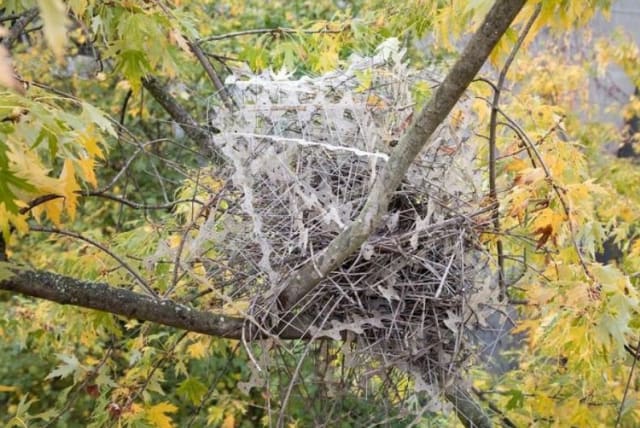Birds make nests out of anti-bird spikes pins to adapt to city life - study

Dutch researchers have found that birds have built nests from the very same anti-nesting spikes built to keep them away in what is the ultimate adaptation to city life.
Bird-brained is a phrase that is usually used to make fun of people for being silly or stupid. But given the behavior of many of our feathered “friends,” it should be regarded as a compliment.
It has been known for years that crows identify people who interfere with their nests and zoom in on them from above for weeks or months every time they spot them. Now, researchers from the Naturalis Biodiversity Center and the Natural History Museum Rotterdam (NHMR) in the Netherlands have found that some birds have created their nests from sharp, metal, anti-nesting spikes that people install to scare them away.
This, said the researchers, is an ultimate adaptation to life in the city. “It’s like a joke, really,” said Naturalis biologist Auke-Florian Hiemstra. “Even for me as a nest researcher, these are the craziest bird nests I've ever seen.”
The spikes are meant to prevent birds from building nests – but birds are not so easily scared away. Researchers from the two natural history museums collected nests of a carrion crow and a Eurasian magpie that were largely built with spikes that should have deterred the birds.
The adaptability and creativity of urban birds seem to know no bounds. Writing in the scientific journal Deinsea, NHMR director and biologist Kees Moeliker who co-authored the study said: “Just when you think you’ve seen it all after half a century of studying natural history, these inventive crows and magpies really surprise me again.”
The study was entitled “Bird nests made from anti-bird spikes.”
Clever birds: How magpies made nests of anti-bird spikes
It all started with the discovery of a huge nest in the courtyard of an Antwerp hospital, which was spotted by one of the patients. High up in a tree, magpies made a huge nest of up to 1,500 metal spikes. For this particular nest, birds have pulled as many as 50 meters of anti-bird pins from the eaves. “An impregnable fortress,” says Hiemstra, “because the magpies appear to be using the pins exactly the same way we do – to keep other birds away from their nest.”
Magpies make a roof on their nest to prevent the robbery of eggs and young, and they specifically look for thorny plants in nature for this purpose. Spiky branches keep hungry egg robbers away. But in the city, there is another option – the anti-bird spikes. “They are literally made to keep birds at bay, which is how they seem to be used by birds as well.”
It isn’t just one pair of magpies that have ventured into the bird-repellent material. The article describes several magpie nests with anti-bird spikes as nesting material. This behavior has already been seen in the Netherlands, Belgium and Scotland. Other sharp materials, such as barbed wire and knitting needles are also used by magpies for the roof of their nests.
It was already known that birds are not easily deterred by the pins. The Parkdale Pigeon gained fame for not being scared away by anti-bird spikes and several videos show the rebellious behavior of birds tearing the spikes off roofs. The collaboration between the Leiden and Rotterdam museums has now resulted in the first scientific publication showing that birds also use those anti-bird pins as nesting material.
Doctoral student Hiemstra has been studying the use of artificial materials in animal structures and has previously published on the use of face masks and plastic plants in bird nests. He also regularly encounters condoms, fireworks, cocaine wraps, sunglasses, and windshield wipers as nesting material for his coots (mud hens).
Jerusalem Post Store
`; document.getElementById("linkPremium").innerHTML = cont; var divWithLink = document.getElementById("premium-link"); if (divWithLink !== null && divWithLink !== 'undefined') { divWithLink.style.border = "solid 1px #cb0f3e"; divWithLink.style.textAlign = "center"; divWithLink.style.marginBottom = "15px"; divWithLink.style.marginTop = "15px"; divWithLink.style.width = "100%"; divWithLink.style.backgroundColor = "#122952"; divWithLink.style.color = "#ffffff"; divWithLink.style.lineHeight = "1.5"; } } (function (v, i) { });

